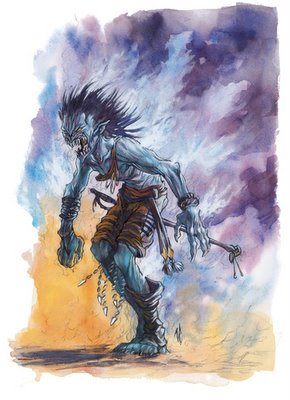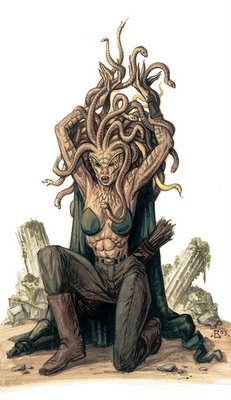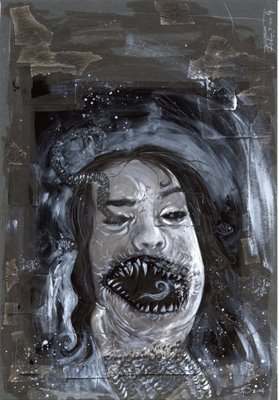THENOLIAN WORLD
This is the world of the necromancer named the Thenolian... Strange encounters, weird lands, disgusting thangs!!! All of this is here!!!
Fables #123
Saga of Old City/ Greyhawk Adventures #1
Against The Giants: The Liberation Of Geoff
Dragon Wing - The Death Gate Cycle T1
The Lost Chronicles, T3: Dragons of the Hourglass Mage
Complete Book of Humanoids
Hey girl...
Fireborn
Player's Handbook 3... uuuh...

The book is misleadingly named, as only one new class is introduced for the Divine and Primal power source each. Instead, the focus is clearly on the Psionic power source, which introduces four new classes to the table: The Ardent, a leader who uses psionic magic to psychically influence the tide of battle; the Battlemind, whose psionics allow him to gain the tactical advantage that a defender requires; the Monk, a striker who uses harnesses psionic power to achieve total mobility and the Psion, a controller who brings down her foes through telekinetic assaults or psychic attacks.
The first thing you should know about the Psionic classes is that they introduce several new mechanics. The Psion, Ardent and Battlemind make use of power points – the quantity of which depends on a character’s level and is replenished after a short or extended rest – to augment their psionic powers, and have no encounter powers to speak of, save for some utility powers. Instead, they have a host of at-wills that can be boosted by these power points. For example, a Level 7 at-will called Ego Crush, allows a Battlemind to deal 1[W] + Constitution damage, and denies his target the ability to gain combat advantage until the end of his next turn. When boosted, it can be used as an opportunity attack or when maxed out, deals double damage against each enemy within a close burst.
Third poker night
The Tourist
CTHULHU TECH RPG

he first thing I notice with any product is the artwork, and I have to say that the graphic design and art in CthulhuTech really hits home for the setting. Much of the artwork is rather simple, but extremely evocative of the moods and feelings this kind of game wants the players to experience. I’m already scared out of my wits at the thought of giant alien robots scouring through ruined cities, seeking out the flesh of my would-be hero everyman. These two genres speak to me in similar ways, as my favorite giant-mecha anime is Neon Genesis Evangelion which features normal people thrust into bizarre and otherworld circumstances and that seems to mesh pretty damn well with the concepts underlying the Cthulhu mythos as well. It just has a little more badass sprinkled in, is all!
The second thing I noticed after spending some time with the material is that it’s not just two genres slapped together, a lot of work has gone into developing a rich history and backstory for the horrifying world of the future. If there’s one thing I love in a new RPG resource, it’s lots of history and backstory that can be used or at least inspires ideas for game masters and players alike. I was thrilled when the Call of Cthulhu system was revamped for the d20 system after 3rd Edition D&D was released, but now that 4th Edition has been out for several months I think the market is ripe for all of the new horror content that is being released.
This really is a rich book packed full of awesome content, and seeing that it is now under the helm of Catalyst Game Labs who I trust implicitly because of their efforts on Battletech, I think there will be many more supplements released for this that will provide months of excellent gameplay and developing storylines. There are already two supplements released, though I did not get a chance to read through them yet. Vade Mecum provides more options for your character (races and professions), new rules for para-psychics, more monsters, more mecha, and lots more! Dark Passions is another supplement which further details the smaller factions / cults which are at work in the universe, providing a good counterpoint to the main book’s development of the major players.
Happy new year!!!





Maria J. William

This is Lo!!!

Origin of the vietnamese people
The Dragon Lord of the Lac served as protector of the kingdom under the Hung kings, as the Golden Turtle spirit guarded the realm of Au Lac. As the potent kings of the early kingdom and other cultural heroes joined the spirit world after death, they too became powerful spirits whose aid and sympathy could be evoked by subsequent generations in time of need. The historical memory of the Hung kings and King An Duong was transmitted over centuries not only in myth and legend but through the physical presence of hundreds of village shrines and altars. Before these visible emblems of ancient glory, rituals periodically bound the people to their shared past and to each other.
The Sovereign Stone

The first book was set during the reign of King Tamaros of Vinnegael, the most powerful Human kingdom and the father of Prince Helmos and his younger half brother, Prince Dagnarus. The next two were set approximately two hundred years later and followed Dagnarus in his bid to take over the world as well as the story of his allies and those who would try to stop him.
There are four races on the main continent, Loerem, with fifth and sixth races that appear in the second and third book, one from a distant continent or world. The main four races are each primarily dedicated to one of the four elements. The Humans are associated with earth/stone, the Elves with air/wind, the Orks with Water/the Sea, the Dwarves with fire. The fifth race, the Taan, are associated with the void. The sixth race, the Pecwae, apparently rely on earth magic drawn from stones such as turquoise. Each race's magic-users are able to draw power from their element, as well as outside their racial element. However the vast majority stick to their primary element.
The races each have their own god or gods. The Humans worship a pantheon always referred to as a group "the gods" not as individual gods. The Orks worship the gods who live in their holy mountain and pay special attention to signs read by their shamans. The Elves worship the Father and Mother, and the Dwarves worship the Wolf. The Taan also have a pantheon of gods, however, unlike the other races, they seem to separate them as individuals representing or having power over various events. The Pecwae are never really discussed, but frequently refer to simply the gods, similar to humans. It is not made clear in the books if all the gods are one group or separate groups. However, since the gods gave the Sovereign Stone to all the races through the King of Vinnegael it is likely that there is one pantheon perceived differently by the different races.
The gods had originally rewarded King Tamaros for his faith by giving him the power to create Dominion Lords, a group of holy warriors who were to promote peace and understanding among the four main races. As strife continued, the King went to the gods and asked them for something to help with peace among the races. They gave him the Sovereign Stone which could be split into four portions each representing one of the four elements. The King took this gift and gave one portion to each of the races so that they could create their own Dominion Lords. A fifth portion of the Stone that was unseen, save by the young Prince, Dagnarus, was the Dagger of the Vrykyl, representing the void in the center.
Humans: In this world Humans are in tune with the magic of earth. This power is controlled through the church. While once having been a largely unified race in the nation of Vinnengael, war and time have split them apart into varying nations and ethnic groups, such as the Nimoreans.
Orks: In this world Orks are excellent seafarers in touch with the magic of the water. They are master engineers and are dedicated to the reading of omens. The authors specifically stated that they wanted the Orks in this world to be more then the "usual cannon-fodder", and thus made several changes to the average fantasy orc.
Dwarves: In this world the Dwarves are associated with the element of fire. They are master horsemen, living as nomads on the great plains. Any dwarf who is unable to ride with the tribe or is convicted of a crime is sentenced to be "the Unhorsed" and cast off in one of the three "Cities of the Unhorsed". The dwarf god is "the Wolf" and they believe that if they lead a good life their soul is reborn in the body of a wolf, so they can run in the pack of their god.
Elves: In this world, Elves segregate themselves from the rest of the world. They are ruled by the Divine, the religious authority, who is aided by the Shield of the Divine in all matters relating to military. Power struggles between the Shield and the Divine are frequent. There are Twelve noble houses of elves of which everyone is either a member or a follower of, as well as an exiled house that appears in the second and third books. The Elves live in very dense family homes where generations of elves will live in one home. Elves practice a form of ancestor worship, and seem to have a faintly Asian feel to their culture.
Alix new blog!!!
SUTHEIRA... Dangerous aussie wizardess!!!
 She's wife of John Belt, and a really good friend, with huge heart and baby in the womb! Cassy, a nicy aussie friend with her beautiful blog, full of wonderful pictures and gentle words for those she love. This is the OCEAN OF JOY
She's wife of John Belt, and a really good friend, with huge heart and baby in the womb! Cassy, a nicy aussie friend with her beautiful blog, full of wonderful pictures and gentle words for those she love. This is the OCEAN OF JOYThe Lost Room
This is an amazing history!!! In three parts only, but I hope they are a true and big season after that! Really original, with many known actors and actress (like Juliana Margulie!!!). Great moment!
Heavy Gear Rpg...

John Belt, the australian DM for the athasian campaign of Time, is also GM on many canadian games like Tribe 8, Jovian Chronicles or... Heavy Gear! I'm very interested by this one, and with many tips of this excellent game master, I planned a small adventure for my players.
Necromancers in the D&D worlds...
 In a band, it's hard to play a necromancer, no matter the kind of this. I like to play wizard with power over the undead and more particulary over the spectre and other ethereal ones. The alignement of my characters is usually Neutral Evil, but it's very rare that I splint off from my band, my magical powers are more often interesting for a bunch of warriors and rogues than an another source of treats. I like Necromancers!!! Beware Ha Noian players, Perran the lord of undead is here! LOL
In a band, it's hard to play a necromancer, no matter the kind of this. I like to play wizard with power over the undead and more particulary over the spectre and other ethereal ones. The alignement of my characters is usually Neutral Evil, but it's very rare that I splint off from my band, my magical powers are more often interesting for a bunch of warriors and rogues than an another source of treats. I like Necromancers!!! Beware Ha Noian players, Perran the lord of undead is here! LOLThe Ghostwalk campaign...
 Yiiiish!!! Begining of the Ghostwalk campaing with my bunch of terrific (and very handsome) players; My beloved Càm, her girlfriend Naïma, Nicy Ngoc and Hê, the chinese sorceress!!! Dungeon Master: Stephen!
Yiiiish!!! Begining of the Ghostwalk campaing with my bunch of terrific (and very handsome) players; My beloved Càm, her girlfriend Naïma, Nicy Ngoc and Hê, the chinese sorceress!!! Dungeon Master: Stephen!THUA THIEN-HUE

Thirty-one burial urns more than 2,000 years old have been unearthed at an excavation site in Thua Thien-Hue Province.
Archeologists from the Viet Nam History Museum and Thua Thien-Hue History and Revolution Museum also found more than 100 stone, glass and iron objects at the 156sq.m excavation site in the past three months.
They said the objects in Huong Chu Commune in Huong Tra District, which belong to the Sa Huynh culture (1000BC-AD200), could help identify the people residing in the central region at that time.
The Sa Huynh culture, situated in central and southern Viet Nam, were most likely the predecessors of the Cham people, the founders of the kingdom of Champa.
The site at Sa Huynh was discovered in 1909, and was found to be rich in locally worked iron artefacts, typified by axes, swords, spearheads, knives and sickles.


































